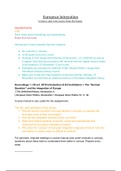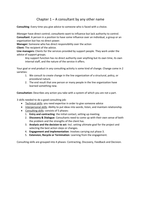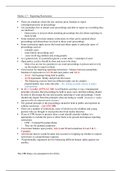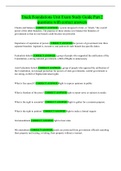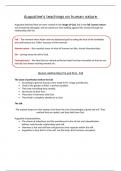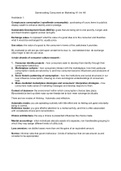lectures and extra notes from the books
Important terms
Lists
Extra notes about something non-substantively
Notes from the book
Introduction is less important than the chapters
● No Lectures in January
● no Brussels Excursion (June)
● Handing in First Assignment Monday 25 November –on CANVAS as well as
in pigeon hole (discuss procedure with seminar lecturer) digital version needs
to be handed in 25 November 12 am (noon).
● Examples are provided on CANVAS Under ‘Module Week 4 assignment
theoretical analysis primary source’.
● Make sure to ask any final questions during the seminar. Monday 18
November you will have an extensive lecture on European integration theory.
Hoorcollege 1 | 30 oct. 2019 Introduction & EU Institutions + The “German
Question” and the integration of Europe
( The Unfinished History, introduction,1)
( European Union Politics, Introduction + European Union Politics 10, 11, 12)
Course manual is very useful for the assignments.
The four main questions of this course:
1. Why did several countries in Europe decide to voluntary co-operate and
surrender some of their sovereignty?
2. How did this integration process evolve over time?
3. What were factors (political, economic, social and international) that
influenced the European integration process?
4. Why does the “process” of European integration stagnate at times? And why
are reforms in certain areas so difficult to achieve?
For seminars: required readings in course manual (and under modules in canvas),
questions about these texts to understand them better in canvas. Prepare every
week.
----------------------
,What is European integration? : Voluntary cooperation of states that agreed on
cooperation through surrendering some of their national sovereignty
→ Outcome of competing ideas (from different countries), opportunities, chances,
convictions, calculations, personal preferences, contextual factors and ambitions
This voluntary cooperation has a long history. There were several peace treaties, we
can now consider as the start of the European Union. (Much older than after WWII)
The EU is the first institution which is successful and still present.
Important to realize is what exactly is sovereignty!
Sovereignty: ‘the legal capacity of national decision makers to take decisions without
being subject to external restraints’.
In European Context it would guarantee that the nation states have their own
sovereignty, the other states are not allowed to fully control the others. But because
of being part of the EU, the states have to hand over some power.
European Integration → Surrendering sovereignty → European Institutions
How to organize a european community?
How much sovereignty to transfer:
● How much authority would be given to the EU?
● Which policy fields could be organised on a European level and which policy
fields had to remain firmly in the hands of the member states?
● How much power should the EU have and to what extent could it interfere in
national settings?
Trias Politica forms the basis of European states
Dealing with the question of sovereignty:
1. Supranationalists: advocates of a form of international cooperation in which
countries give up some control of their affairs as they work together to achieve
shared goals.
→ interests of citizens of Europe as a whole
2. Federalists: advocates of a system of government in which powers are divided
and shared by a central governments and its sub- divisional governments.
→ interests of citizens of Europe as a whole + the individual member states
→ Spinelli wanted to integrate the European nations all at once by way of direct
elections for a European constitutional assembly.
,3. Intergovernmentalists: advocates of a system in which national states cooperate
on the intergovernmental level without giving up their sovereignty.
→ interests of the individual member states
Different ideas on how the European Union should be organized.
European Institutions:
Interesting: Some
institutions do
multiple tasks of
the trias politica.
Not that clearly distinguished tasks. Trias politica doesn’t 100% come true. We see a
big mix of different powers and responsibilities, which makes it a very difficult
institution understand (for the citizens):
, 1. European Commission:
- It has different departments
- Supranational
- 28 members, president primus inter pares
- President (Jean Claude Juncker) of the Commission: nominated by the
European Council
- President selects Commission members and asks approval from the EU
Parliament
Main tasks European Commission
1. Right of Initiative ( proposals for directives, regulations, decisions and
recommendations); The European Commission comes up with proposals.
2. Executive power: implementation → mostly ‘monitoring’. The European
Commission makes sure that when a proposal is approved, the EU also acts
like it.
3. Representing the EU beyond EU borders;
4. Drafting of policy documents on European integration – preparatory work.
2. Council of EU/ Council of Ministers
! Council of EU is different than Council of Europe
- Intergovernmental


